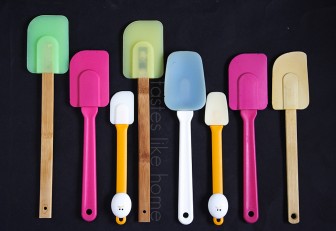Hi Everyone, I love my rubber spatula. Lest one becomes jealous of the other, let me say that I love my rubber spatulas. I have a small collection and honestly, you know when you love something or someone so much and they have been so good to you, that you can’t remember life before them? That’s how much I love my rubber spatulas. I’ll walk in to a kitchen store or any store that sells kitchen tools and equipment and the first thing that I gravitate towards is the row of spatulas.
A rubber spatula is an indispensible cooking tool. It’s great for tossing, folding, mixing, stirring, scraping and even mashing things to a smooth paste. They make good spreaders too. It does all these tasks without bruising; it does it gently and delicately. Spatulas are great to cooking eggs and shameless lovers to batters. Oh and they love to show off when scraping down and around the sides of bowls, pots and pans.

Show me your motion
Choose a spatula that is flexible enough to work easily around the bends and curves of pans and bowls and yet, it should be firm enough to mash your devilled eggs stuffing to a smooth paste without you having to press down with a lot of strength. Your spatula should be able to mix your potato salad without breaking up your potatoes and still be gentle enough to fold egg whites to make meringue or angel cake. If a spatula is too rigid then it will not yield and offer you the light touch and delicacy required. On the other hand, if it is too soft and without much resistance, it can make a mess out of things and cause you to overwork your batter or mixture. You can easily find yourself going over a surface more than once to remove remnants.
It’s hot to be cool
Whether the spatula is made with rubber, plastic or silicone, you always want to read the label to ensure that it is heat resistant or high heat resistant. This is necessary so that when your spatula comes into contact with your hot cooking pots and pans, it does not start to lose its shape or resistance. You should be able to stir a pot or pan and rest it right in and on the edges of your pot/pan for a few minutes while you busy yourself tending to something. Please note that I am not saying that you should leave it there for 10 minutes and then go about your business; you won’t leave any type of pot spoon in a pot for that time anyway. I’m talking here about 3 – 4 minutes if that long.
In seeking a heat resistant spatula, you also want to ensure that you get one where the handle also does not over heat and that it’s cool to the touch.
Get a grip

A spatula is made up of two main parts – the handle and the head that contains a shaped piece of plastic, rubber or silicone. Both parts are important and complement each other, however, most attention is often paid the head when choosing a spatula and the handle is an afterthought. Don’t make that mistake. Pay attention to the handle – the size (width and length), the shape, the material and the sturdiness of the handle.
Choose a spatula with a handle that is comfortable to hold and work with. Think of how you plan to use the spatula. For example, one of your spatulas may need to have a long handle so that as you cook with it, the steam emanating from the pot or pan does not come into ready contact with your hands. On the other hand, you may need to choose a spatula with a short handle to give you more control as you mix.
Shape is important. Remember that this is something that you will be grasping and holding in your hands for an extended period of time depending on what you are making. Therefore, you need to ensure that it fits well in your hand. The handle should not be sharp nor should it be grazing against your skin as you work with it. You want to know that when you grasp the handle, you can hold it firmly in your hand, that it is not constantly slipping or causing you to adjust your hold on the handle.
Spatulas handles are made with generally four types of material – wood, bamboo, metal or a rubbery-silicone-plastic type of material. You will notice that the handle of some spatulas carry the same material coating that the spatula head is made of. None is better than the other really, it is a personal preference based on what works for you. I tend to opt for the bamboo and the rubbery-hard plastic handles. The metal handles I find too flat and they hurt my hand because when I grasp them, I always have to place a thumb on the handle to keep the spatula in place as I work, whereas with the other handles, I can grasp firmly with my fingers wrapping around it comfortably.
Sizing up your shape
There is a generally uniform size for spatulas but then there are those where the heads are larger and others, the spatulas are small and sometimes shaped differently. Different shapes and sizes can work for different things. For example, the smaller spatulas, I use to mix up sauces in small bowls or when mixing small amounts of compound butter.
I do not own or use any of the oversized (head) spatulas simply because I don’t have any use for them or never make things in such large quantities that I would need to use them. I use the regular sized spatulas with the square-like heads where one side is straight and the other side is curved. This works great for me for mixing, folding, scraping and tossing. I have one that has the head where the tip looks like a knife, I only have it because it came with a set but I never use it. This is one of the drawbacks about buying certain things in a set – often it is just one item in the set that you use. Take knives for example. Never buy one of the knife block sets, invariably you will never use more than 2 or 3 of those knives maximum. A set of steak knives is altogether different.
Anyway, getting back to the spatulas. You don’t need to be obsessed like me nor do you need to have 6 spatulas. Buy based on your needs. I’m not just saying this to justify my obsession but I do use all of my spatulas for different things. For example, there are a couple that I use exclusively for batters. Another couple that I use for eggs and mixing and folding certain things. The pair of small ones I explained about before. And another couple I use for anything. All are heat resistant – heads and handles and they fit my hand well and do not stress out my wrist or fingers.
● The next time you’re making potato salad – mix with a spatula and see the difference.
● The next time you’re making an omelette – pry, toss and use your spatula to fold it.
● The next time you’re making a soufflé, meringue or some delicate-batter goody, fold with a spatula.
● The next time you want to scrape all the remnants from the bowl of the beaten eggs or batter – use a spatula.
● The next time you mix, blend or process something, clean the sides with a spatula and mix.
● The next time you want to spread something evenly and smoothly, use a spatula.
● The next time you cook and want to clean the sides of the pot and get all the goodness back into the pot, run your spatula along the edges.
● The next time… okay I’ll stop now. I think you get the picture.





